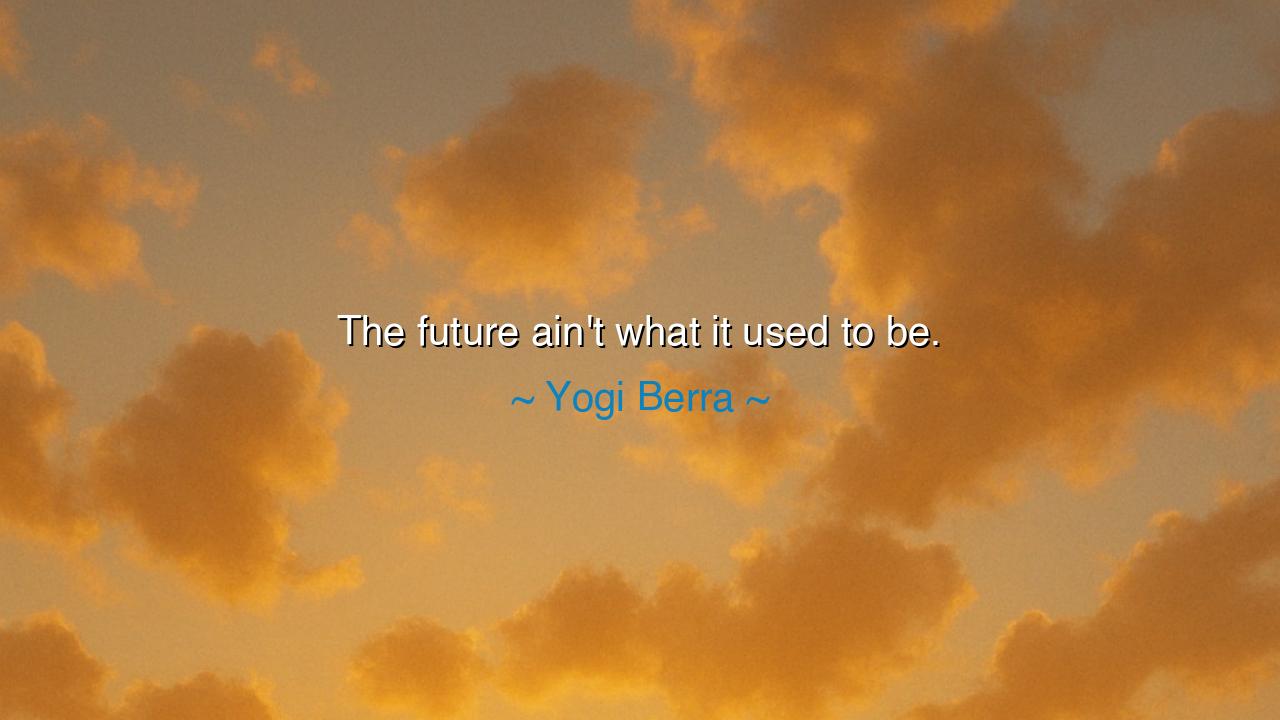
The future ain't what it used to be.






Yogi Berra, with his characteristic wit and wisdom, delivers a truth that resonates deeply in the human experience: "The future ain't what it used to be." This deceptively simple statement holds profound meaning about the nature of change, expectations, and human resilience. To say that the future is no longer as it once seemed is to acknowledge that life does not unfold according to the neat, predictable paths we imagine for it. The future is a fluid, evolving force, always shifting, unpredictable, and often more surprising than we anticipate. This truth challenges us to rethink our notions of progress, success, and destiny.
In the ancient world, the idea of the future was often treated with a sense of reverence and awe, but also with uncertainty. The oracle at Delphi was revered for offering glimpses into the future, though its answers were often cryptic, leaving those who sought guidance to wrestle with the ambiguity of what was to come. The Greeks knew that the future could not be easily known or controlled. Just as their gods were unpredictable and their fates uncertain, so too was the world before them. Berra’s words resonate with this ancient understanding: the future may be shaped by our actions, but it is never as clear-cut or as certain as we would like to believe.
The Romans, with their grandeur and power, also believed in shaping the future through strength and strategy, yet their empire fell, proving that no matter how mighty a civilization might be, it too is vulnerable to the forces of time and change. The fall of Rome is a perfect historical example of how expectations of permanence and control over the future can be shattered. Just as the Romans imagined their empire lasting forever, we, too, sometimes view our future as if it will unfold in a linear and predictable fashion. But, as Berra reminds us, the future is not what we think it will be.
In more recent times, technological advancements have created a similar shift in how we view the future. The 20th century brought about revolutionary changes in the way we live, work, and connect. The notion of the future, once rooted in stability, was replaced with a rapidly accelerating pace of change. The advent of the internet, the rise of artificial intelligence, and the constant evolution of society have shown us that the future, once thought to be a destination, is now a series of unforeseen twists and turns. Berra’s statement is a nod to this unpredictable progression of the world—what seemed like a certain future is no longer so clear.
The lesson of Berra's words is one of adaptability and humility. The future, in its essence, cannot be controlled. It is like a river, constantly flowing, carving new paths, reshaping the land it touches. To cling to rigid ideas of what the future should be, or to become entrenched in the belief that things will unfold in one predetermined way, is to set oneself up for disappointment and frustration. We must accept that the future will never match our expectations completely, and instead, we must learn to embrace change and uncertainty with grace and courage.
Consider the story of Thomas Edison, whose invention of the light bulb radically altered humanity’s future. Edison could not have predicted the full extent of his creation’s impact, but he was always willing to adapt and experiment in ways that shaped the world in unexpected directions. The future he envisioned was not a fixed outcome, but a process of trial, error, and unexpected discovery. His willingness to accept the unknown allowed him to shape a future far different from what he had initially imagined.
So, the action to take is clear: embrace the unknown and adapt to the future that unfolds. Do not be bound by rigid expectations or past dreams. The future may not be what it used to be, but it is full of possibility and new opportunities. As Berra teaches us, instead of fighting the change, we must flow with it, trusting that each turn of the river brings us closer to something new and beautiful. The future is not a place to fear or resist, but a landscape to explore, to shape, and to live within with curiosity and resilience.






AAdministratorAdministrator
Welcome, honored guests. Please leave a comment, we will respond soon